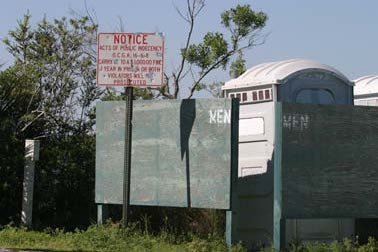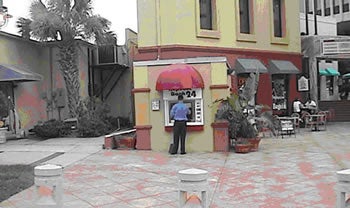by Diane Zahm
Translation(s): O uso da Prevenção Criminal Pela Conceção Ambiental (Portuguese) PDF
Crime prevention through environmental design (CPTED) is an approach to problem solving that asks, what is it about this location that places people at risk, or that results in opportunities for crime? In other words, why here? Three case examples will illustrate this point:
Case #1: Custodial workers routinely find evidence of smoking, drinking and vandalism in a high school lavatory.
Why here? The lavatory is in an isolated area of the building, adjacent to a ticket booth and concession stand that are active only during athletic events. The school's open lunch policy allows students to eat anywhere on campus, while monitors are assigned only to the cafeteria.
CPTED response: A lock is installed on the lavatory door, and it remains locked unless there is an athletic event. The open lunch policy has been revised: students are still allowed to leave the cafeteria but must eat in designated areas, and a faculty member is charged with patrolling these areas during lunch periods.
Case #2: The back wall of a building in an office center is repeatedly tagged with graffiti.
Why here? The taggers have selected an area that is out of the view of passers-by: a rear corner location where two buildings come together at the end of a poorly lit service lane. Visibility is further reduced by hedges at the site’s perimeter. Businesses in the office center are open from 9 AM to 5 PM during the week; however the tagged building is next to a roller skating rink where activity peaks at night and on weekends.
CPTED response: Hedges are trimmed and wall-mounted light fixtures installed along the service lane, with motion detection lighting in the problem area. The skating rink agrees to change to a “no re-admission” policy to keep skaters inside the building and away from the office property.
Case #3: ATM patrons at a bank are being robbed after dark.
Why here? The bank is situated along a commercial strip in a neighborhood with vacant properties and abandoned businesses. The ATM is in the front corner of the bank building, and the drive-through teller windows are at the side of the building, around the corner from the ATM. Robbers hide in the darkened drive-through teller area and attack unsuspecting ATM users after they complete a transaction.
CPTED response: The bank installs a fence at the corner of the building, creating a barrier between the ATM and the drive-through teller area.
In each of these case examples, asking why here? reveals that opportunities for crime and other problems arise out of a variety of environmental conditions related to the building, the site, and the location and how the place is used. Solving a problem thus requires a detailed understanding of both crime and place, and the response should consider one of the three objectives of crime prevention through environmental design: control access, provide opportunities to see and be seen, or define ownership and encourage the maintenance of territory.
This guide is a resource for understanding and using crime prevention through environmental design as a problem-solving tool. The guide explains the basic principles of CPTED and outlines a process for identifying problems, evaluating the physical environment, and identifying strategies that will remove or reduce opportunities for crime.
Crime prevention through environmental design is an approach to problem solving that considers environmental conditions and the opportunities they offer for crime or other unintended and undesirable behaviors. CPTED attempts to reduce or eliminate those opportunities by using elements of the environment to (1) control access; (2) provide opportunities to see and be seen; and (3) define ownership and encourage the maintenanceof territory. †
CPTED is unusual when compared with other crime prevention or security measures because it specifically focuses on aspects of the design, while the other measures tend to be directed at target hardening, i.e., denying access to a target using locks and bars, or using sensors and cameras to detect and identify an offender, supported by security guards. CPTED is unusual also when compared to some police activities. This is because CPTED encourages prevention and considers design and place, while policing has traditionally valued an efficient and effective response to incidents, and the identification and arrest of offenders.
CPTED may be distinctly different from traditional policing, yet it is very consistent with problem oriented policing, in four ways:††
†For a more detailed introduction to CPTED, see Crowe (2000), Crowe and Zahm (1994), and National Crime Prevention Council (1997).
††Herman Goldstein’s book, Problem-Oriented Policing (1990) offers greater detail on these and other aspects of POP.
Crime prevention through environmental design is a relatively new term, but the use of design for safety and security is not. Caves and cliff dwellings, and castles and moats are good historical examples. Requirements for street lighting grew out of a need to distinguish legitimate travelers from outlaws and thieves.
Contemporary approaches, including CPTED, emerged out of research on the relationship between crime and place, theories known variously as environmental criminology, situational prevention, rational choice theory, or routine activities theory, among others.† Each theoretical approach focuses on the crime event and how a criminal offender understands and uses the environment to commit a crime. Like CPTED, this research asks, why here? The research reveals:
† See also Newman (1972), Jeffery (1971, 1977), Brantingham & Brantingham (1981, 1984), Clarke (1980, 1992), Cohen & Felson (1979), and Cornish & Clarke (1986).
Crime prevention through environmental design examines crime problems and the ways in which various features of the environment afford opportunities for undesirable and unwanted behaviors. CPTED attempts to remove or reduce these opportunities by changing various aspects of the building, the site, and the location, and how that place is used.
These changes are directed toward three basic objectives, each of which is described briefly below, including examples of CPTED strategies:

This is exactly how NOT to do CPTED! 1. It is dreadfully ugly; 2. the walls around the portable bathroom make it impossible to observe undesirable and unwanted behaviors. Credit: Ronald Clarke
Examples:
Examples:

This ATM is placed well, using good CPTED features and has an unobstructed view from the street and patrolling police. Credit: Randy Atlas
Examples:
Note that while CPTED is a crime prevention program, it focuses on design, not safety, and on productive use, not security. Design features are “supported” by locks, guards and alarms. Target hardening and security measures are not the primary means for improvement. Note, too, that although CPTED is frequently considered the responsibility of police, many of the tools and techniques are things that fall outside the purview of policing. This is why CPTED is a team effort, one that officers participate in but do not necessarily control.
You may order free bound copies in any of three ways:
Online: Department of Justice COPS Response Center
Email: askCopsRC@usdoj.gov
Phone: 800-421-6770 or 202-307-1480
Allow several days for delivery.
Send an e-mail with a link to this guide.
* required
Error sending email. Please review your enteries below.